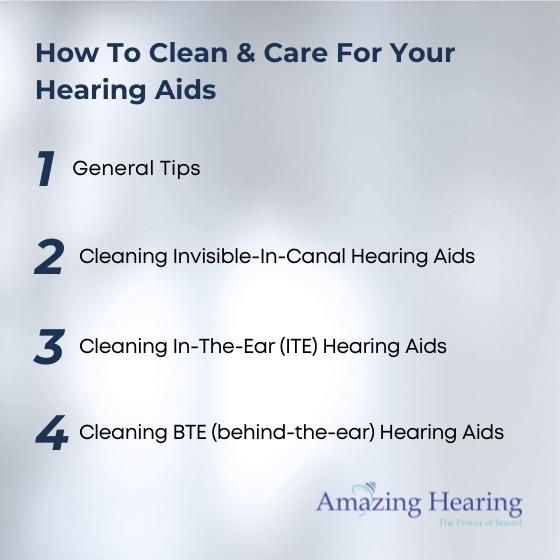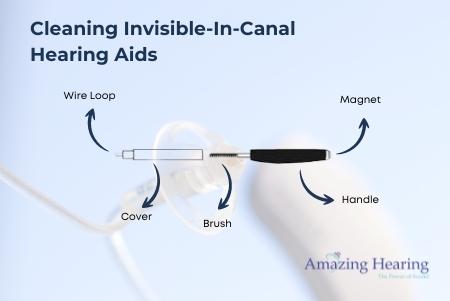Like many devices and assets, hearing aids will not perform optimally if they are not being maintained properly. In contrast, regular cleaning, as well as appropriate hearing aid care instructions from your hearing care specialist, can help you get years of dependable hearing.
Therefore, it is a good idea to become acquainted with the various components of hearing aids and how to maintain them before you begin. Today, we will be sharing some key tips on caring for your hearing aids, followed by specific guidelines on how to clean the different hearing aids types.
General Tips On How To Care For Your Hearing Aids
Establish good habits:
Before cleaning your hearing aids, wash your hands carefully.
Remove your hearing aids before you shower so that water and soap do not harm them. Wash your face and hair without putting them on especially if you are using products such as sprays or gels.
Get the necessary cleaning tools:
A wax pick and brush are required for at-home cleaning. Earwax can accumulate in the hole where sound emerges from a hearing aid, resulting in muffled or no sound.
If left alone for a long period of time, it may cause damage to the receiver.
Use the pick and brush to remove earwax carefully.
Alternatively, newer hearing aids feature a replaceable wax barrier, which is both quick and easy. Simply just replace it.
Remember that you’re only using these simple equipment to help you maintain your hearing aids in excellent working order:
- Hearing aid cleaning brush (A magnetic battery removal tool is included in some brushes)
- Wax pick tool
- Wax guards (Wax guards are made by individual manufacturers, and they can differ somewhat from one another)
Clean your hearing aids before bedtime:
Cleaning your hearing aids before going to bed allows them to “breathe” (dry out) for several hours overnight.
Avoid using wet wipes that include chemicals or alcohol since they can harm the equipment.
A dry tissue or towel should suffice for a quick cleaning of your hearing aids.
Avoid excessive heat or cold:
Expect that the hearing aids will function differently than usual if it is below freezing temperature outdoors and you might experience poor battery signals. Thus, it is important to avoid exposing your hearing aids to extreme temperatures (both hot and cold).
You may use your hearing aids in these circumstances, but you can also keep them in your pocket rather than stowing them in your jacket.
Similarly, if you’re going to the pool on the hottest day of the summer, keep your hearing aids in a proper box, rather than leaving them on a sunny poolside table.
If you read on, we will show you how to clean the different types of hearing aids.
Cleaning Invisible-In-Canal Hearing Aids
Your specialist should provide the necessary tools to clean this type of hearing aid. A MultiTool equipment should be given to use.
- Clean away any wax traces from around the microphone aperture and sound outlet with the MultiTool.
- Press the MultiTool brush through the hole – if you need to clean larger ventilation openings.
- Use a wire ventilation cleaning tool to clean tiny holes. Insert the cleaning wire into the hole.
- Wipe the surface of the instrument with a clean cloth.
Cleaning In-The-Ear (ITE) Hearing Aids
- To clean the aperture in your hearing aid, dampen a soft-bristled toothbrush or one supplied by your hearing healthcare professional and clean it. Instead of being trapped inside, any loose matter should fall out when you hold the hearing aid with the aperture you’re cleaning pointing down.
- Remove any items that did not come out with the brush with a wax pick or hook after that.
- If you can see any visual debris within the sound port, replace the wax guards.
- To finish, clean the device with a clean, dry towel or tissue. This will remove any debris from your hearing aid.
Cleaning BTE (behind-the-ear) Hearing Aids
- Remove any debris from the equipment with a light brush or a dry cloth. Examine the microphone ports for any obstructions and clean them gently with a modest brush.
- There are various types of earmolds, and some can be removed and cleaned.
If your earmold is a tube based one, you may remove it from the earhook.
Washing the molds is a standard cleaning procedure.
Soap and warm water are ideal for degreasing your earmolds.
Note that: you must clear all traces of water from the tube and vent by means of a bulb blower or compressed air.
- If your earmold has electronics, clean it and change the wax guards as needed.
- Your tubes should be replaced every 6-8 months, as when the material is used over time, it will harden and shrink, lowering the amount of sound produced.
- Some earmolds, particularly those produced of softer materials, might discolor and stain over time. Before using them, wait for the molds to dry completely. Do not put any alcohol or other chemicals on the moulds.
Hearing aids are designed to assist you to hear better in different environment. If you want your hearing aid to perform well, you must take good care of it.
Consult your hearing aids specialist and if you want your hearing aids to last as long as possible, clean them and have them adjusted at least once a year.



